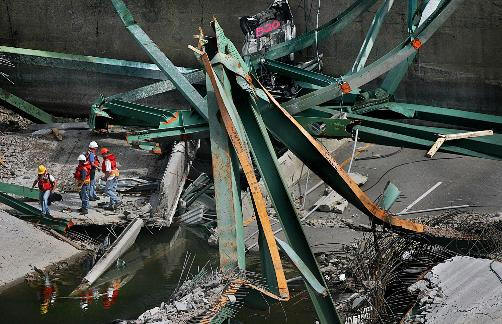|
I-35W bridge was doomed from the start by
Tony Kennedy and Paul McEnroe, Tribune staff writers, October 26, 2008 Original designers of the Interstate 35W bridge in Minneapolis likely
neglected to calculate the size of key gusset plates that eventually
failed, a human mistake that culminated 40 years later when 13 people
died after the span collapsed, federal safety investigators have found.
They also have determined that corrosion of certain gusset plates,
extreme heat and shifting piers did not contribute to the bridge's
collapse on Aug. 1, 2007, according to sources with direct knowledge of
the probe. In three weeks, investigators will present their findings to
the National Transportation Safety Board (NTSB), which will publicly
review the draft report in a hearing Nov. 13 at the board's Washington
headquarters. After that, the board will use the draft as the basis for
its final report on the probable cause of the collapse and
recommendations for preventing future disasters.
 The reflections of workmen are cast in standing waters at the site
of the I-35W bridge collapse during investigation, evaluation
and recovery efforts in August 2007.
Had key steel gusset plates been designed properly -- they were one-half
inch thick instead of an inch -- the bridge would have been able to
withstand tons of concrete and steel added in two renovation projects as
well as the 287-ton construction load on the bridge the day it
collapsed, sources said.
In January, NTSB Chairman Mark Rosenker was
criticized by U.S. Rep. Jim Oberstar, D-Minn., and others for placing
too much early emphasis on gusset plate failure as the potential cause.
But the investigators' findings appear to validate Rosenker's early
stance.
The safety investigators found records showing that the bridge
designers knew how to calculate the thickness of gusset plates, but
probably did not perform that task for the bridge's center portion,
where the initial failure occurred. Investigators leave open the
possibility that the design firm, Sverdrup and Parcel, carried out the
calculations but erred. That assessment is based on a review of the
original work papers of the St. Louis-based firm, which was later
acquired by Jacobs Engineering of San Francisco.
| 


